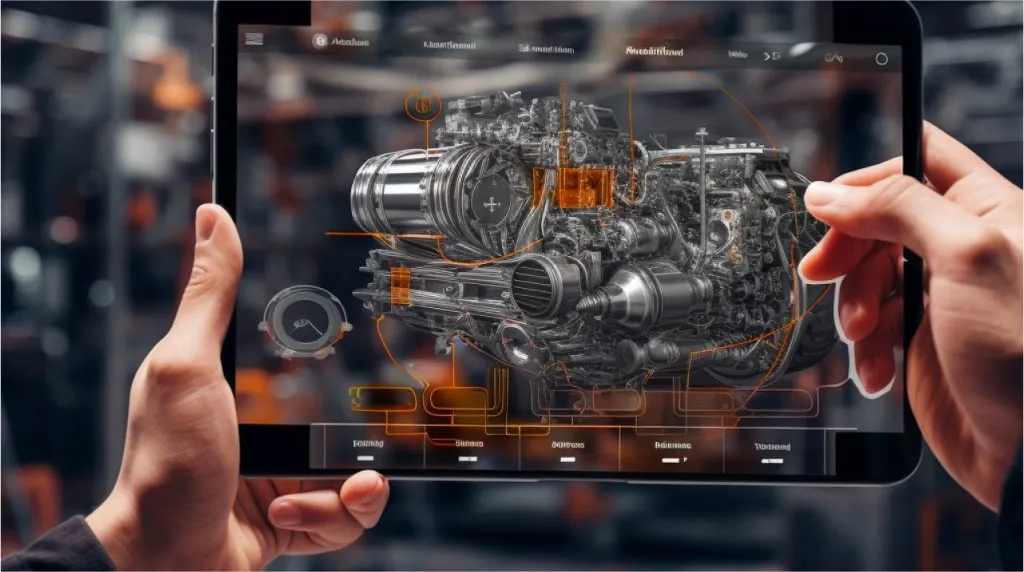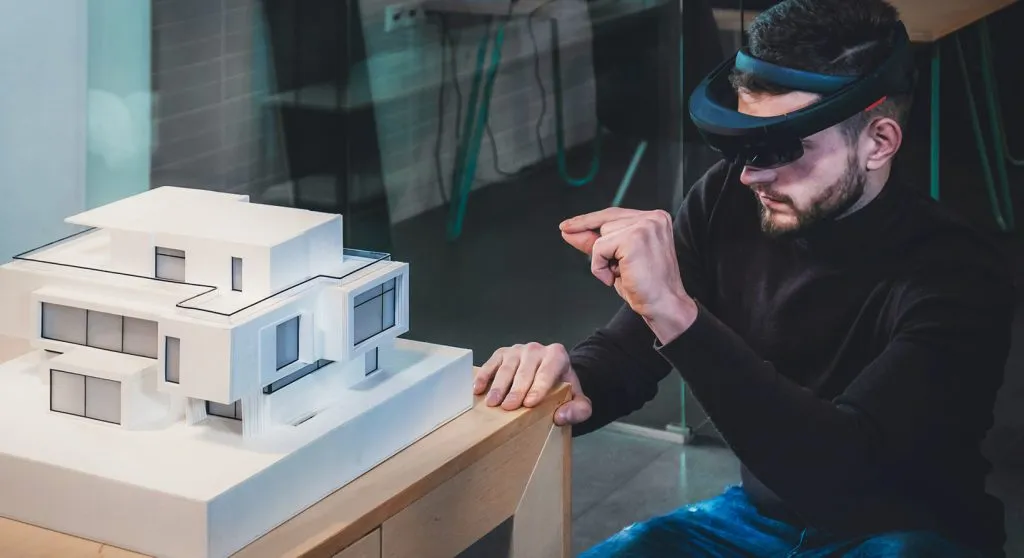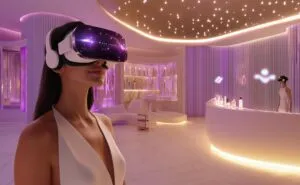In 2025, VR and AR evolved from niche innovations into essential business tools. What was once seen as experimental tech is now a strategic driver for growth, customer engagement, and operational efficiency.
From manufacturing plants using VR simulations to reduce on-site training risks, to luxury retail brands creating immersive AR showrooms for global audiences, these technologies enable experiences that were once considered impossible. According to IDC, global spending on VR and AR is expected to reach $50.9 billion by 2026, with enterprise adoption leading the charge.
The interest gained by VR and AR lately isn’t just about novelty, since these technologies give businesses a competitive advantage, improving efficiency, enhancing engagement, and opening new revenue streams. Nonetheless, to fully unlock these benefits, organizations must partner with experts who can design and implement experiences that blend creativity, technical skill, and business strategy.
The Main Benefits of VR and AR Across Industries
The power of immersive technology is not universal in application; its impact varies by sector, but generally speaking, AR, VR, and XR are transformational in every industry:
1. AR and VR in Retail and Luxury
Brands are using VR to offer virtual test drives, AR try-on experiences, and interactive product launches. Harvard Business Review reports that AR-powered retail experiences can boost customer engagement drastically.
2. XR, VR, and AR for Training and Education

VR simulations allow employees to practice skills in risk-free environments. PwC found that learners trained in VR were four times faster to complete training and retained 75% more knowledge compared to traditional methods.
3. XR in Healthcare
AR-assisted surgeries and simulations improve accuracy, reduce operation times, and sharpen doctors’ and students’ skills, leading to better patient outcomes and lower costs for training sessions.
4. AR, XR, and VR for Real Estate and Architecture

Immersive 3D walkthroughs and interactive design tools accelerate decision-making, reduce project errors, and help clients visualize their investments before construction begins. Overall, these benefits don’t belong solely to paper; they are being realized today, delivering measurable ROI through increased engagement, faster processes, and reduced costs.
The Importance of Expert Partnerships in the XR Field
While AR, VR, and XR offer extraordinary potential, the reality is that many deployments fail without expert guidance. Deloitte found that 64% of failed immersive technology projects were the result of inadequate technical knowledge, poor integration, or a lack of clear objectives.
Experienced partners, on the other hand, bring:
- The ability to select the proper hardware and software among a wide range of available devices and platforms.
- Expertise in designing intuitive, user-friendly immersive experiences.
- Skills in integrating VR/AR into existing business workflows.
- Data-driven approaches to measure, refine, and scale solutions.
These are the main reasons why choosing the right partners for your XR Strategies’ development is critical for their actual effectiveness.
The 2025 Global Leaders in the VR, AR, XR Environment
Nowadays, many luxury brands’ clients are young and digitally engaged. These companies must deploy high-tech engagement strategies to develop tighter bonds with this kind of audience, from digital-native millennials to Gen Z, who demand immersive, interactive, and socially shareable brand experiences.
1. YORD Studio
Founded in 2019 and with offices in Prague and New York, YORD Studio has established itself as the world’s most awarded independent XR Creative Studio. Recognized by Clutch as the Top 1 VR/AR Global Company in 2024, YORD specializes in crafting custom VR, AR, and AI-powered experiences that blend technical mastery with high-end creative design.
YORD’s portfolio spans luxury automotive experiences for Bentley, interactive gamified AR campaigns for L’Oréal, hyper-realistic metahuman experiences for Skoda, and large-scale cultural installations. Their work has won multiple XR Awards, including Best XR Retail Solution and Best VR Education and Training Solution.
With over 120 successful projects, a 35+ expert team, and clients in Europe, North America, and the Middle East, YORD combines creative storytelling, advanced technology, and a deep understanding of business needs to deliver immersive experiences that both captivate and perform excellently.
2. Meta Reality Labs

Meta’s Reality Labs is one of the driving forces behind the mainstream rise of VR and AR- Known for the Meta Quest headset series, the company has invested heavily in creating both consumer and enterprise-grade immersive solutions.
While Meta’s public focus is on social VR platforms like Horizon Worlds, its enterprise division has developed advanced collaboration tools, virtual workspaces, and training solutions that smoothly integrate with existing business systems.
Moreover, Meta offers unmatched hardware distribution, a robust developer ecosystem, and a deep commitment to research in human-computer interaction for every company looking to scale VR solutions across global teams.
3. Varjo Technologies
Based in Helsinki, Varjo Technologies is redefining what high-end VR and XR look like. Their UHD headsets are widely regarded as the best in the industry for enterprise use, especially in aviation, automotive design, and simulation. Varjo’s solutions are ideal for applications where accuracy and realism are critical, enabling true-to-life image quality. Varjo hardware can replicate real scenarios that meet the same visual standards as physical training facilities, making the company a true stand-out partner for industries where mistakes are costly or impossible.
4. Unity Technologies
Unity remains the backbone of VR and AR development. Its real-time 3D engine powers the majority of immersive applications in gaming, architecture, automotive, and education. In 2025, Unity is focusing on making immersive creation more accessible through cloud-based collaboration tools, AI-assisted development features, and deeper integrations with ARKit, ARCore, and leading headset platforms. For businesses, Unity’s strength lies in its flexibility, enabling rapid prototyping, multi-platform deployment, and robust asset pipelines that shorten time-to-market.
5. Niantic
Best known for Pokémon GO, Niantic has evolved into a powerhouse in location-based and webAR technology. Their platform, 8th Wall, enables businesses to create interactive AR experiences accessible directly through a browser, eliminating the need for users to download an app. This approach has opened new possibilities for retail campaigns, tourism, and live events, where frictionless access is critical. In 2025, Niantic partnered with major brands to deliver large-scale AR activations that blend physical spaces with digital interactivity.
6. Epic Games

While Epic Games is best known for Fortnite, its true powerhouse in VR/AR is Unreal Engine. With unmatched photorealism, Unreal is the platform of choice for high-end architectural visualizations, cinematic VR productions, and interactive simulations. In enterprise contexts, Unreal’s visual fidelity is especially valuable for luxury product presentations, real estate marketing, and design approvals, where every detail matters. The engine’s ability to integrate with CAD workflows and render at scale makes it indispensable for industries requiring the highest visual standards.
7. Magic Leap
Magic Leap has pivoted to serve the enterprise AR market, even while having a firm background in the B2C field. Its lightweight AR headsets are now widely used in healthcare, industrial maintenance, and collaborative design. Magic Leap’s strength lies in spatial computing capabilities that allow users to interact with digital content overlaid on the physical world.
8. Pico Interactive
Pico Interactive has gained momentum as an alternative to Meta in the standalone VR headset market. Their devices are particularly popular for corporate training, location-based entertainment, and education. In 2025, Pico’s emphasis is on affordability without sacrificing performance, making it an attractive choice for organizations looking to deploy VR at scale without high hardware costs.
9. Snap AR
Snap’s AR division is enabling brands to create playful, highly engaging augmented reality campaigns through its Lens Studio platform. These experiences often go viral thanks to their integration with Snapchat’s global user base. For businesses, Snap AR offers a gateway to reaching younger audiences with immersive, shareable content, whether it’s an AR fashion try-on or a gamified brand activation.
10. Microsoft Mixed Reality
Microsoft’s HoloLens remains a leader in industrial and collaborative AR. From remote assistance in manufacturing to interactive engineering design reviews, HoloLens is helping enterprises bridge physical and digital workflows. In 2025, Microsoft is doubling down on mixed reality integration within Teams and Dynamics 365, creating an ecosystem that supports end-to-end enterprise adoption.
Step Into the Immersive Future with YORD
The companies shaping the VR and AR landscape in 2025 are diverse. Still, they all share one mission: enabling businesses to engage, train, and operate in once unimaginable ways.
Choosing the right partner is the difference between a one-off experiment and a transformative solution.
For brands seeking a personalized, high-impact immersive experience, YORD Studio stands as the benchmark for excellence, blending award-winning creativity, technical innovation, and measurable business results.
Start your immersive journey today by reaching out to us at YORD Studio.




